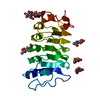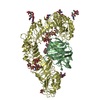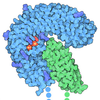[English] 日本語
 Yorodumi
Yorodumi- PDB-7drb: Crystal structure of plant receptor like protein RXEG1 with xylog... -
+ Open data
Open data
- Basic information
Basic information
| Entry | Database: PDB / ID: 7drb | |||||||||
|---|---|---|---|---|---|---|---|---|---|---|
| Title | Crystal structure of plant receptor like protein RXEG1 with xyloglucanase XEG1 | |||||||||
 Components Components |
| |||||||||
 Keywords Keywords | PLANT PROTEIN / LRR / PTI / Glycoside hydrolase / Inhibitor | |||||||||
| Function / homology |  Function and homology information Function and homology informationresponse to other organism / cellulase activity / polysaccharide catabolic process / defense response / plasma membrane Similarity search - Function | |||||||||
| Biological species |  Phytophthora sojae (eukaryote) Phytophthora sojae (eukaryote) | |||||||||
| Method |  X-RAY DIFFRACTION / X-RAY DIFFRACTION /  SYNCHROTRON / SYNCHROTRON /  MOLECULAR REPLACEMENT / Resolution: 3.3 Å MOLECULAR REPLACEMENT / Resolution: 3.3 Å | |||||||||
 Authors Authors | Sun, Y. / Wang, Y. / Zhang, X.X. / Chen, Z.D. / Xia, Y.Q. / Sun, Y.J. / Zhang, M.M. / Xiao, Y. / Han, Z.F. / Wang, Y.C. / Chai, J.J. | |||||||||
| Funding support |  China, China,  Germany, 2items Germany, 2items
| |||||||||
 Citation Citation |  Journal: Nature / Year: 2022 Journal: Nature / Year: 2022Title: Plant receptor-like protein activation by a microbial glycoside hydrolase. Authors: Yue Sun / Yan Wang / Xiaoxiao Zhang / Zhaodan Chen / Yeqiang Xia / Lei Wang / Yujing Sun / Mingmei Zhang / Yu Xiao / Zhifu Han / Yuanchao Wang / Jijie Chai /   Abstract: Plants rely on cell-surface-localized pattern recognition receptors to detect pathogen- or host-derived danger signals and trigger an immune response. Receptor-like proteins (RLPs) with a leucine- ...Plants rely on cell-surface-localized pattern recognition receptors to detect pathogen- or host-derived danger signals and trigger an immune response. Receptor-like proteins (RLPs) with a leucine-rich repeat (LRR) ectodomain constitute a subgroup of pattern recognition receptors and play a critical role in plant immunity. Mechanisms underlying ligand recognition and activation of LRR-RLPs remain elusive. Here we report a crystal structure of the LRR-RLP RXEG1 from Nicotiana benthamiana that recognizes XEG1 xyloglucanase from the pathogen Phytophthora sojae. The structure reveals that specific XEG1 recognition is predominantly mediated by an amino-terminal and a carboxy-terminal loop-out region (RXEG1(ID)) of RXEG1. The two loops bind to the active-site groove of XEG1, inhibiting its enzymatic activity and suppressing Phytophthora infection of N. benthamiana. Binding of XEG1 promotes association of RXEG1(LRR) with the LRR-type co-receptor BAK1 through RXEG1(ID) and the last four conserved LRRs to trigger RXEG1-mediated immune responses. Comparison of the structures of apo-RXEG1(LRR), XEG1-RXEG1(LRR) and XEG1-BAK1-RXEG1(LRR) shows that binding of XEG1 induces conformational changes in the N-terminal region of RXEG1(ID) and enhances structural flexibility of the BAK1-associating regions of RXEG1(LRR). These changes allow fold switching of RXEG1(ID) for recruitment of BAK1(LRR). Our data reveal a conserved mechanism of ligand-induced heterodimerization of an LRR-RLP with BAK1 and suggest a dual function for the LRR-RLP in plant immunity. | |||||||||
| History |
|
- Structure visualization
Structure visualization
| Structure viewer | Molecule:  Molmil Molmil Jmol/JSmol Jmol/JSmol |
|---|
- Downloads & links
Downloads & links
- Download
Download
| PDBx/mmCIF format |  7drb.cif.gz 7drb.cif.gz | 412.7 KB | Display |  PDBx/mmCIF format PDBx/mmCIF format |
|---|---|---|---|---|
| PDB format |  pdb7drb.ent.gz pdb7drb.ent.gz | Display |  PDB format PDB format | |
| PDBx/mmJSON format |  7drb.json.gz 7drb.json.gz | Tree view |  PDBx/mmJSON format PDBx/mmJSON format | |
| Others |  Other downloads Other downloads |
-Validation report
| Summary document |  7drb_validation.pdf.gz 7drb_validation.pdf.gz | 4.2 MB | Display |  wwPDB validaton report wwPDB validaton report |
|---|---|---|---|---|
| Full document |  7drb_full_validation.pdf.gz 7drb_full_validation.pdf.gz | 4.2 MB | Display | |
| Data in XML |  7drb_validation.xml.gz 7drb_validation.xml.gz | 76.7 KB | Display | |
| Data in CIF |  7drb_validation.cif.gz 7drb_validation.cif.gz | 103.4 KB | Display | |
| Arichive directory |  https://data.pdbj.org/pub/pdb/validation_reports/dr/7drb https://data.pdbj.org/pub/pdb/validation_reports/dr/7drb ftp://data.pdbj.org/pub/pdb/validation_reports/dr/7drb ftp://data.pdbj.org/pub/pdb/validation_reports/dr/7drb | HTTPS FTP |
-Related structure data
| Related structure data |  7drcC  7w3tC  7w3vC  7w3xC  4mnaS S: Starting model for refinement C: citing same article ( |
|---|---|
| Similar structure data | Similarity search - Function & homology  F&H Search F&H Search |
- Links
Links
- Assembly
Assembly
| Deposited unit | 
| ||||||||||||||||||||||||||||||||||||||||||||||||
|---|---|---|---|---|---|---|---|---|---|---|---|---|---|---|---|---|---|---|---|---|---|---|---|---|---|---|---|---|---|---|---|---|---|---|---|---|---|---|---|---|---|---|---|---|---|---|---|---|---|
| 1 | 
| ||||||||||||||||||||||||||||||||||||||||||||||||
| 2 | 
| ||||||||||||||||||||||||||||||||||||||||||||||||
| Unit cell |
| ||||||||||||||||||||||||||||||||||||||||||||||||
| Noncrystallographic symmetry (NCS) | NCS domain:
NCS domain segments:
NCS ensembles :
|
- Components
Components
-Protein , 2 types, 4 molecules ABCD
| #1: Protein | Mass: 25519.551 Da / Num. of mol.: 2 Source method: isolated from a genetically manipulated source Source: (gene. exp.)  Phytophthora sojae (eukaryote) / Gene: EGL12-G / Production host: Phytophthora sojae (eukaryote) / Gene: EGL12-G / Production host:  Trichoplusia ni (cabbage looper) / References: UniProt: Q30BZ2 Trichoplusia ni (cabbage looper) / References: UniProt: Q30BZ2#2: Protein | Mass: 104238.852 Da / Num. of mol.: 2 Source method: isolated from a genetically manipulated source Source: (gene. exp.)   Trichoplusia ni (cabbage looper) / References: UniProt: A0A2I8B6R1 Trichoplusia ni (cabbage looper) / References: UniProt: A0A2I8B6R1 |
|---|
-Sugars , 5 types, 20 molecules 
| #3: Polysaccharide | Type: oligosaccharide / Mass: 1721.527 Da / Num. of mol.: 2 Source method: isolated from a genetically manipulated source #4: Polysaccharide | 2-acetamido-2-deoxy-beta-D-glucopyranose-(1-4)-2-acetamido-2-deoxy-beta-D-glucopyranose Source method: isolated from a genetically manipulated source #5: Polysaccharide | beta-D-mannopyranose-(1-4)-2-acetamido-2-deoxy-beta-D-glucopyranose-(1-4)-2-acetamido-2-deoxy-beta- ...beta-D-mannopyranose-(1-4)-2-acetamido-2-deoxy-beta-D-glucopyranose-(1-4)-2-acetamido-2-deoxy-beta-D-glucopyranose Source method: isolated from a genetically manipulated source #6: Polysaccharide | Type: oligosaccharide / Mass: 1235.105 Da / Num. of mol.: 2 Source method: isolated from a genetically manipulated source #7: Sugar | ChemComp-NAG / |
|---|
-Details
| Has ligand of interest | N |
|---|---|
| Has protein modification | Y |
-Experimental details
-Experiment
| Experiment | Method:  X-RAY DIFFRACTION / Number of used crystals: 1 X-RAY DIFFRACTION / Number of used crystals: 1 |
|---|
- Sample preparation
Sample preparation
| Crystal | Density Matthews: 2.73 Å3/Da / Density % sol: 56.26 % |
|---|---|
| Crystal grow | Temperature: 291.15 K / Method: vapor diffusion, hanging drop Details: 0.1M MES monohydrate pH 6.0, 14% (w/v) polyethylene glycol (PEG) 4000 |
-Data collection
| Diffraction | Mean temperature: 100 K / Serial crystal experiment: N |
|---|---|
| Diffraction source | Source:  SYNCHROTRON / Site: SYNCHROTRON / Site:  SSRF SSRF  / Beamline: BL19U1 / Wavelength: 0.979 Å / Beamline: BL19U1 / Wavelength: 0.979 Å |
| Detector | Type: MAR scanner 345 mm plate / Detector: IMAGE PLATE / Date: Oct 1, 2018 |
| Radiation | Protocol: SINGLE WAVELENGTH / Monochromatic (M) / Laue (L): M / Scattering type: x-ray |
| Radiation wavelength | Wavelength: 0.979 Å / Relative weight: 1 |
| Reflection | Resolution: 3.3→50 Å / Num. obs: 41355 / % possible obs: 97.3 % / Redundancy: 3.6 % / Biso Wilson estimate: 93.38 Å2 / CC1/2: 0.712 / Net I/σ(I): 13 |
| Reflection shell | Resolution: 3.3→3.36 Å / Num. unique obs: 4059 / CC1/2: 0.712 |
- Processing
Processing
| Software |
| ||||||||||||||||||||||||||||||||||||||||||||||||||||||||||||||||||||||||||||||||||||||||||||||||||||||||||||||||
|---|---|---|---|---|---|---|---|---|---|---|---|---|---|---|---|---|---|---|---|---|---|---|---|---|---|---|---|---|---|---|---|---|---|---|---|---|---|---|---|---|---|---|---|---|---|---|---|---|---|---|---|---|---|---|---|---|---|---|---|---|---|---|---|---|---|---|---|---|---|---|---|---|---|---|---|---|---|---|---|---|---|---|---|---|---|---|---|---|---|---|---|---|---|---|---|---|---|---|---|---|---|---|---|---|---|---|---|---|---|---|---|---|---|
| Refinement | Method to determine structure:  MOLECULAR REPLACEMENT MOLECULAR REPLACEMENTStarting model: 4MNA Resolution: 3.3→49.01 Å / SU ML: 0.56 / Cross valid method: THROUGHOUT / σ(F): 1.34 / Phase error: 34.67 / Stereochemistry target values: ML
| ||||||||||||||||||||||||||||||||||||||||||||||||||||||||||||||||||||||||||||||||||||||||||||||||||||||||||||||||
| Solvent computation | Shrinkage radii: 0.9 Å / VDW probe radii: 1.11 Å / Solvent model: FLAT BULK SOLVENT MODEL | ||||||||||||||||||||||||||||||||||||||||||||||||||||||||||||||||||||||||||||||||||||||||||||||||||||||||||||||||
| Displacement parameters | Biso max: 189.29 Å2 / Biso mean: 99.5759 Å2 / Biso min: 30 Å2 | ||||||||||||||||||||||||||||||||||||||||||||||||||||||||||||||||||||||||||||||||||||||||||||||||||||||||||||||||
| Refinement step | Cycle: final / Resolution: 3.3→49.01 Å
| ||||||||||||||||||||||||||||||||||||||||||||||||||||||||||||||||||||||||||||||||||||||||||||||||||||||||||||||||
| Refine LS restraints NCS |
| ||||||||||||||||||||||||||||||||||||||||||||||||||||||||||||||||||||||||||||||||||||||||||||||||||||||||||||||||
| LS refinement shell | Refine-ID: X-RAY DIFFRACTION / Rfactor Rfree error: 0 / Total num. of bins used: 15
|
 Movie
Movie Controller
Controller






 PDBj
PDBj






